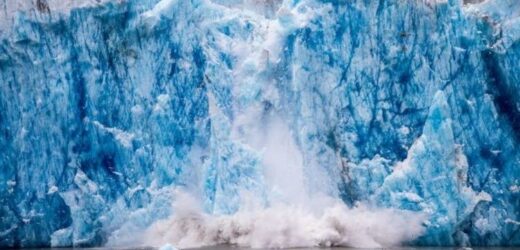Antarctica: Satellite images reveal ‘mysterious hole’ in ice glacier
We use your sign-up to provide content in ways you’ve consented to and to improve our understanding of you. This may include adverts from us and 3rd parties based on our understanding. You can unsubscribe at any time. More info
The British-owned autonomous underwater vehicle can travel for miles underwater and ice. It set off on a 65-day voyage set off on January 6 to probe the environmental conditions around the gigantic Thwaites Glacier. The Thwaites Glacier is one of the biggest in Antarctica, stretching across 74,000 square miles. Boaty McBoatface is being accompanied by a fleet of other small robot submarines.
It will be sent out under the ice to help a team of academics, including scientists from the University of St Andrews.
The submarines will help provide valuable access as the ice is so thick that even an icebreaker ship, called Nathaniel B Palmer, would not be able to cut through it.
The team set off from Punta Arenas in Chile on the 100th anniversary of polar explorer Sir Ernest Shackleton’s death.
Experts have warned that recent dramatic changes at the glacier could have a catastrophic effect on global sea levels, raising the height by up to 65cm.


The Thwaites is already depositing 50 billion tonnes of ice into the ocean annually.
This accounts for around four percent of the current sea-level rise worldwide.
But there are fears a floating section of ice at the front of the glacier could “shatter like a car windscreen” in the next five to ten years.
This section had been relatively stable up until recently.
And a voyage aboard the icebreaker Nathaniel B Palmer is part of the International Thwaites Glacier Collaboration (ITGC).
This is a five-year project jointly funded by the UK’s Natural Environment Research Council and the US National Science Foundation.

The team is being led by researchers from the University of East Anglia (UEA).
They will carry out tests around the ice shelf to gain insights into its behaviour.
Dr Rob Hall, from UEA, the chief scientist in charge of the voyage, said: “It’s very exciting, though also daunting, to be leading this campaign to make critical measurements of the ocean under and around this vulnerable ice shelf.
“The team have completed a month of quarantine to ensure everyone is safe, and now we’re looking forward to putting our wide range of scientific instruments into the water to see what we will learn about how the ocean melts the ice shelf from below.
DON’T MISS
Yellowstone supervolcano warning after magma chamber discovery [REPORT]
NO fourth Covid vaccine needed as new booster guidance given [INSIGHT]
Mystery bite mark on Great White Shark sparks Megalodon theory [REVEAL]


“We’re already monitoring the sea ice extent carefully to devise the best way to access the area because even this powerful icebreaker ship can’t get through thick sea ice.”
The National Oceanography Centre (NOC) is also involved in the mission.
It will provide innovative technology as part of the ITGC’s TARSAN project.
Dr Alex Phillips, of the NOC, said: “Our science and engineering teams have made enormous strides in pushing the boundaries of how we explore the world’s oceans with underwater technology.
“Autonomous underwater vehicles are vital equipment to enable oceanic research and we’re so excited to be joining the wider ITGC team with Boaty McBoatface, which will travel further under the Thwaites Glacier than ever before.”
Source: Read Full Article


